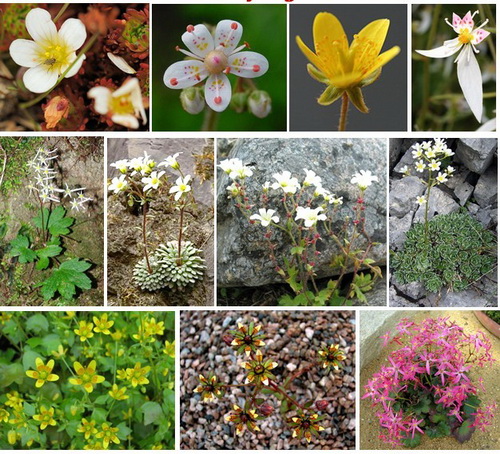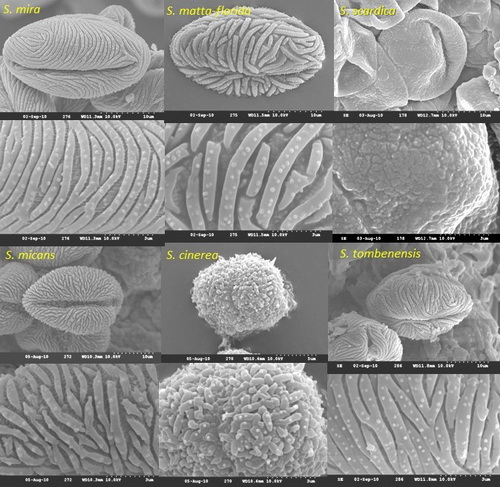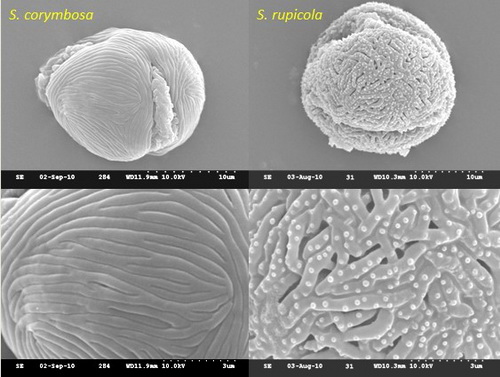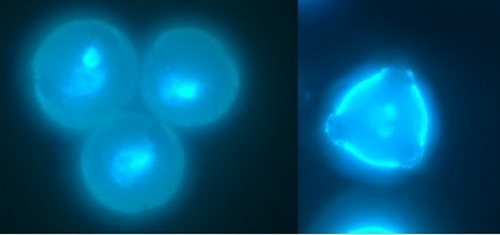Saxifraga is the biggest genus in family Saxifragaceae. It has ca 470 species and 15 sections (Gornall 1987). The plants are herbs that are vegetatively diverse but often claimed to have a uniform floral morphology: So K5 C5 A10 G(2). The genus is arctic-montane primarily in the old-world. It has 10 sections in Europe while 6 sections in Sino-Himalaya.
DNA sequences from four chloroplast and two nuclear regions, however, have shown that Saxifraga is monophyletic only if sections Micranthes and Merkianae are separated as an independent genus (Soltis et al. 1996, 2001). Micranthes is distinguished by its leafless flowering stems, carpels united only at base, reticulate exine, single integument, and ribbed testa.
The talk then simply described the main sections and their habitats. A new species, Saxifraga minutissima, is reported. It is found by Dr D.S.Rawat in the Garhwal Himalaya and have no petals but only 5 stamens. It is believed to belong to sect. Ciliatae.
Phylogenetic reconstruction studies are needed to answer the following questions:
• Are the sections and series monophyletic?
• How to understand evolution of morphological characters which subject to natural selection?
• What is the speciation mechanisms?
• How to compare evolution in Europe vs Sino-Himalaya?
A brief introduction of systematic was given. Haworth (1803, 1812, 1821) was the first botanist to divide Saxifraga into groups. The system from Engler and Irmscher (1916/1919) is one of the most authoritative ones. They divided Saxifraga into 15 sections. Gornall (1987) presented a revised classification with 15 sections, 19 subsections and 34 series.
Phylogeny studies were done by Soltis et al.(1996), Conti et al.(1999), Soltis et al. (2001), Zhang et al. (2008), and Xiang et al. (2012).
With material mainly from herbarium specimens with some fresh plants, experimental observations were made for about 76 morphological characters, including pollen nuclear number, exine morphology, venation (leaf vein structure), and so on.
For pollen nuclear number study, 97 out of 126 species (76.98%) are found binucleate while 29 species are trinucleate (23.02%), The trinucleate species are confined almost entirely to the series belonging to sect. Ciliatae subsect. Hirculoideae.
Details of exine morphology (SEM studies of 132 species) and anatomy (TEM studies of 25 species) are reported. The variation observed was compared with that found in the earlier survey by Ferguson & Webb (1970). Their four main types are confirmed, but we suggest some modifications to their subtypes and the addition of three new ones.Taxonomic conclusions were included.
A leaf venation study surveyed 148 spp. Section Porphyrion, subsection Kabschiawas found having pinnate vein but other sections are either arcuate or palmate. It seems that venation is a systematic informative character.
Comparison was made between molecular and morphological phylogenetic trees. The deep-level phylogenetic tree by six markers (rbcL, matK, trnL-trnF, psbA-trnH, ITS and 26S rDNA) (Soltis et al., 2001) put along side with a phylogenetic tree created from 41 morphological characters which were chosen in the level of section, with same species applied. However, the latter has low bootstrap values due to less character. Both tree share some similarities.
A phylogeny tree are present, which is made from ITS1 and ITS2 sequences from 137 spp. Using Maximum Parsimony method and bootstrap test. Duo1, a nuclear single copy gene controlling the timing of second mitosis of pollen (Borg et al., 2011), is introduced. But the disadvantage of the gene for phylogeny testing was discussed. The matK marker was mentioned as additional data in the future.
The final part of the talk was about the possible areas of collaboration. An updated checklist of Qinghai Saxifraga spp. is the easiest project to complete. New species can be described. The other research interests are testing monophyly of sections & series, origin & distribution of dioecy, mapping distributions in detail: conservation implications, phylogeography of S. sinomontana & its relationship with S. hirculus, and comparative evolution (speciation) in Europe vs Sino-Himalaya
The meeting ended with a free discussion.

Fig. Saxifraga

Fig. Pollen morphology under the scanning electron microscope

Fig. European species lack surface granules, while Sino-Himalayan spp. have granules

Fig. The observations of pollen nuclear number

